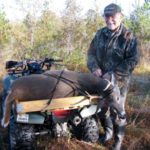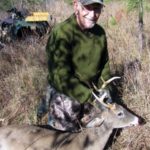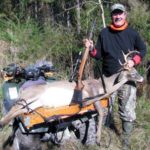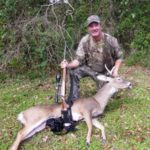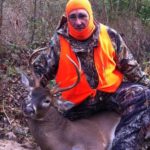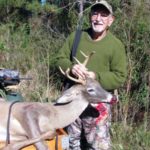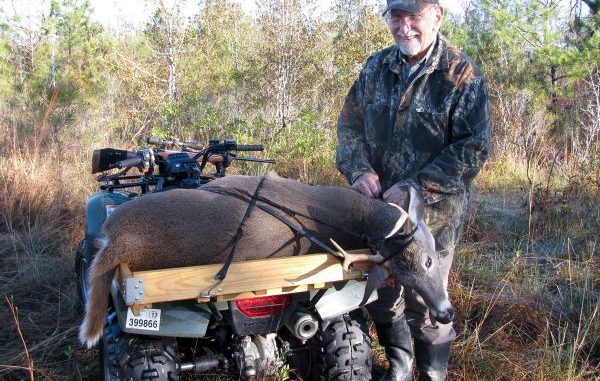
Sure, there might still be some rutting going on in parts of the state, but the deer have wrapped up their mating rituals will be looking for one thing: And it ain’t lovin’.
We were shocked to hear that Eddie had reserved Da Deer Camp’s master bedroom for his nephew Kyle.
“To what does he owe this honor?” Pelayo inquired of Artie as he arranged the Bourre’ table.
“He’s a newlywed — and he’s here with his bride,” Artie winked, while pointing toward the bedroom door.
“Ah,” Pelayo nodded smugly. “Makes sense. Knew it had to be something special.”
Almost on cue, Kyle (resplendent in his full-body camo PJs and slippers) waltzed out of the bedroom door and to the refrigerator, nodding amiably as he passed the crowd. He opened the fridge, grabbed the entire blueberry cheesecake, nodded again, and waltzed back into the room.
“See what I mean?” Pelayo smiled, looking around.
“See what?” Spencer snorted.
“See what I meant about my corn disappearing in one or two days, this late in the season.” Pelayo snapped. “Happens every year!”
Now we were seriously baffled. “What on earth does Kyle and cheesecake have to do with deer corn in the woods in January?” Artie roared.
“Well, the rut’s either still on or petering out around here (eastern Florida Parishes), haven’t you heard?” Pelayo shot back. “We always get a late rut around here, sometimes almost when the season’s closing. But usually from around Christmas to the NFC Playoffs.”
“And?” We all looked at each other wide-eyed and further mystified, and then looked back at Pelayo for any illumination.
“And after their ‘amorous episodes,’ let’s call them, deer are just as hungry for sweets and carbs as we are!” Pelayo explained. “At least that’s my theory. Mix that craving with the cold weather that finally hits us this time of year, and the deer are actually eating and moving around more than they did around Thanksgiving!”
“Whoopdee-Doo!” Spencer shot back. “But it’s all at night! How many mornings and evenings ya gotta waste in a box stand to learn this?”
“Then get out of that box stand and into the woods!” Pelayo yelled. “Try hunting for a change: You might like it, Spence ole boy!”
Indeed, by January, the terrain around most ladder and box stands with their adjoining food plots and feeders looks like cow pastures. The trails leading to them look like cattle ruts. Looking at all that sign really cranks up the nervous system.
But sitting in the stands — morning and evening after morning and evening after morning and evening — without seeing so much as a button buck sure gets old. Then the game cams rub it in, albeit with some entertainment.
Things were getting tense between Pelayo and Spence as the smiling Kyle and Melissa stepped from the bedroom.
“Good grief!” Melissa laughed. “What’s all the yelling about? Les Miles again?”
After the famous Chik-fil-A Bowl (that some had watched at this very camp), it was a reasonable assumption.
But no. When the issue was explained, Melissa seemed mildly amused, if not actually bored with it.
For whatever reason, when we actually got down to “calmly” analyze it around the Bourre’ table, we agreed that Pelayo had a point. Even Spencer seemed to calm down, nodding pensively.
We always notice this late-season pattern. You might also notice that those stacks of deer corn deplete rapidly from your favorite retailers this time of year. That period of exasperating deer nocturnalism that runs roughly from three hours after the season opens till the rut is finally petering out — thank goodness!
By this time, however, many hunters are totally burnt out on the stand-sitting routine and give the diehards the run of the lease.
Fine with us.
It’s been well documented that food is a deer priority after the exertions of the rut. By now the white oak acorns are long gone. Most red and water oaks are depleted or water-logged, soggy and rotten (at least in the areas we hunt) — so corn becomes all the more attractive to deer.
And, as The Temptations and Stones sang: “Ain’t Too Proud to Beg.” At this camp, “We Ain’t Too Proud to Corn!” Not by any means.
And we’re talking dumping 40 maybe 80 pounds across those trail intersections upwind from the climbers we always set up in thickets for the last few weeks of the season. We don’t dump it in a pile, now — instead, we spread it over an area of 20 or 30 square yards. Well spread out. This system has always worked best for us.
Deer-browsing patterns have also changed dramatically from the early season routine. Poking around the thicker woods after several days of fruitless vigils over food plots during the holidays, Pelayo, Eddie and I noticed that deer were munching out on wandering Jew (a green waxy plant with pointed leaves and a little white flower that grows mat-like on the ground — especially near rivers like the Tchefuncte, Tangipahoa and Amite) and on Chinese privet (a bush with little round leaves that grows like crazy all over Southeast Louisiana). Both of these stay nice and green until consistent nights of low-20 temperatures finally shrivel them, which means they often stay green all season long.
Back in October, none of this same wandering Jew and privet had been much browsed. At the time, acorns were dropping heavily, and everything else was still lush and green. But now it looked like a lawn mower had swept it.
And the shiny deer droppings that peppered the area told the rest of the story.
As a bonus, you’ll often find scrapes pawed out of the wandering Jew orchards, especially under overhanging privet branches — which is exactly what determined where we’d set up our climbers for the annual “Playoff Hunt,” as we now call it. Sweetening up such an area with a couple sacks of corn often works like sweetening up a plastic jig with some maaaw-ket shrimp for reds and puppy drum.
Sadly, Da Saints would not be featured in these playoffs. Instead, we settled for booing Da Falcons during the weekend Playoff Hunt. Fun enough.
Our scouting had come earlier on one of those 70-degree days during the Christmas holidays. You know the ones. No point hunting when it’s 64 at daybreak — at least where we hunt. What the heck happens to the deer in this weather anyway? I mean you don’t jump them or anything!
Pelayo had not picked his climbing stand site haphazardly. He was far from his food plot in some thickets of Chinese privet. I was about 300 yards away along the same creek branch bottom.
The deer-trails around our climbers were liberally peppered with droppings. And these didn’t look like Raisinets. They looked like Milk Duds you left on a car seat in the sun and then sat on. Some say this model of droppings are likely from bucks? Whatever. We were pumped for the hunt.
Admonitions from my chum Freddie Rogers who grew up hunting deer in St. Tammany Parish made me feel smug as I humped up the tree, sweating and puffing even in the 29 degree dawn.
“I tell ya, Hom-Boy-Da, the later the better around here, ya follow me?” Freddie would say. “Our ruts are late — sometimes right as the season ends. But always after Christmas, ya follow me? That’s when I see the most deer — and the biggest deer. That’s when they’re finally moving a little during the day — bucks and does, ya understand what I’m saying? And since the leaves have cleared out, it’s when you can actually see them (an important issue for South Louisiana piney woods hunters.)
“After Christmas I get away from the food plots — any scrapes around them are likely visited only at night, anyway. I grab my climber, get into the deep thickets or savannah and climb high.”
Freddie also advised that buck tracks were (generally, speaking) wider and blunter (more hog-like) than doe tracks. He also said they’re less likely to be perfectly aligned. Bucks swagger more, drag their feet more. Such a pattern seemed to characterize many of the tracks in the network of rain-mushy trail intersections Pelayo and I had chosen to put our climbers around.
I had a commanding view of the area, which was a 6-year-old select cut. It seemed just tall and thick enough for deer to feel safe moving through it during the day. But not so tall that I couldn’t see down into it from my 30-foot vantage point. (My rope to haul my rifle up is 30 feet, so I know.)
At 9:45 a.m., while preparing to start humping it down, and chalking up another shivering morning to another fruitless vigil, movement caught my eye. I immediately tensed up. “A deer for sure,” I thought to myself. Up came the binoculars.
And now I really tensed up! Looked like a fairly thick-racked 6-pointer — a glorious trophy for these parts. And he seemed in no hurry. He didn’t seem to be chasing any does. I hadn’t seen any, anyway. Instead, he kept ducking to eat corn. Looked like he was up to the same routine as Kyle the evening before at the refrigerator?
Whatever. Man, I’m nervous, excited, pumped — can’t think straight. He was angling my way. And on a trail that passed within 50 yards of my tree. It would be a cinch — if he kept coming.
Instead, he suddenly stopped and lowered his head. “Maybe he’s checking that scrape I saw while scouting? Or maybe he’s eating corn? Or maybe he’s interested in both?” I kept saying to myself.
My rifle was hanging from a limb, and the deer was so preoccupied it didn’t see me fumbling for it like Jerry Lewis in Cinderfella. I finally got a grip, and the gun went up.
So where’s the deer?
My heart started hammering. I was gasping and crosshairs were shaky when I peered through the glass and caught another gleam of antler in the morning sun.
Geezum! What a beauty! Looks like he’s got some of those palmated antlers, fairly common in south St. Tammany deer. Now the shakes really started.
“Steady the rifle against the tree for heavens sake!” I told myself. OK, got that covered — but now the doggone scope’s fogging up from my gasps!
“Where is he?” I thought to myself. “I can’t find him through the scope!”
Up — down — around. AHH! There he is. The crosshairs danced and finally steadied. Deep breath now, (to further fog up the scope!) Finally it cleared. Ah! — and there’s his shoulder. And he’s rock still — but now he’s behind a tree again!
Then he raised his nose and seemed to sniff the air.
“His tail just flicked! What to do?” I asked myself.
The crosshairs were wobbling crazily. He started looking around.
“But I’m so high,” I reasoned. “And he’s not looking up, thank goodness. Steady, man. Keep cool. Take a deep breath now.
The crosshairs hovered on the juncture of his neck and shoulders — steady now.
I finally steadied the gun against the tree. Deep breath now. But now I can’t find his shoulder! Now he’s moving again! Oops, moving again. Don’t let him get away! — There! Start squeeeeeeezzing — can’t! Hold off! Not yet — he’s obscured again — and moving!
The crosshairs danced as I gasped, and again fogged up the scope. Finally they steadied. Deep breath now. Ah! — there’s his shoulder — steady now. Start — squeezing again— but NOW he’s behind another tree! Hold off!
Now he won’t stand still! He’s moving — still moving! I can’t steady the doggone crosshairs! Brace against the tree and lead him a bit. But now he’s moving again — faster, faster!
Now he’s angling away!
Did he somehow see me? Smell me? Heck, the winds gusting in my face, turning it red! How could he have winded me?
Whatever.
“No way I’m taking a quartering-away shot at this range through these brambles,” I thought to myself. And off he went, melting into the thickets, but heading toward Pelayo.
“Well,” I thought. “I blew it.”
“PE—TOAW!” came the blast from my right — toward Pelayo. He’s the only one in this area today, I thought. It has to be him and probably the same deer.
Half an hour later, Pelayo and I were whooping and high-fiving like lunatics.
Upon skinning the deer, we noticed that the buck had very little fat, very little white or yellow, even along the upper haunches. Apparently that morning he’d been finished with his rutting and was more interested in food — in building that fat back up — than in love.
The corn had probably done the trick.
